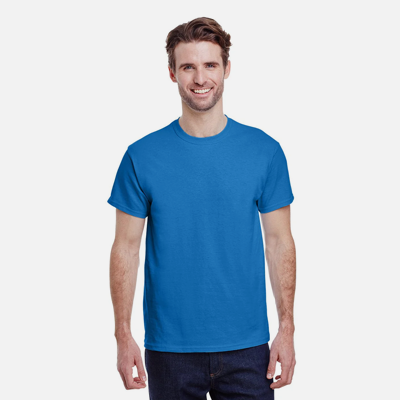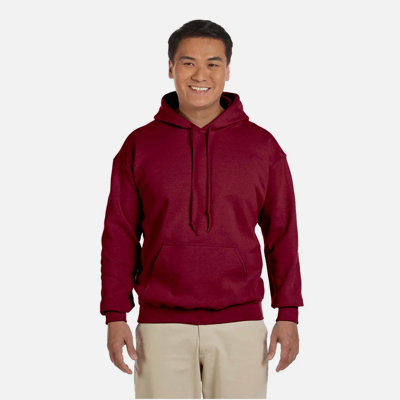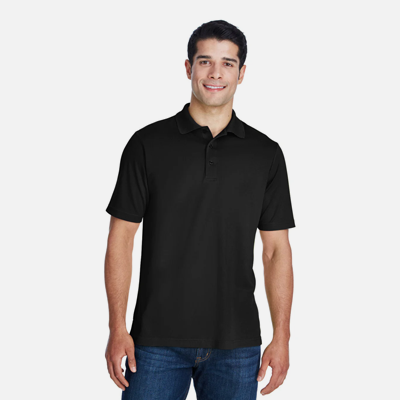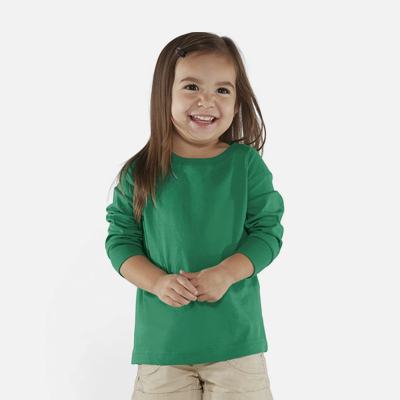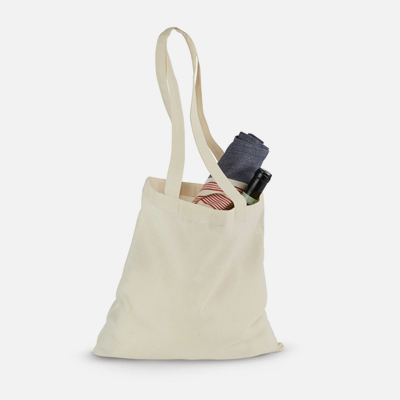T-shirts are primarily made from these two different fabrics. When shopping for blank apparel, you may find yourself deciding between cotton and polyester fabric. Both are popular material, and each have their own unique characteristics, benefits, and downsides.
The biggest difference is that one is natural, and the other is synthetic. Cotton has been a staple in the apparel industry for centuries, while polyester is relatively newer, becoming essential for high-performance athletic wear and moisture-wicking garments. Blending the two fabrics can be a best-of-both-worlds solution, but it's crucial to understand their differences to make the right choice for you.
Deciding between polyester, cotton, or a blend comes down to several factors. Intended use, desired features, print method, and budget are all part of the picture. In this article, we break down everything you need to know about these two fabrics to help you make an informed decision. Let's jump in.
Table of Contents
- What is Cotton Fabric?
- Types of Cotton
- What is Polyester Fabric?
- Types of Polyester
- Blends: The Best of Both Worlds?
- 50/50 Cotton/Poly Blend
- Tri-Blend
- CVC (Chief Value Cotton)
- Printing on Cotton, Polyester, and Blends
- Screen Printing
- DTF Transfers
- Sublimation Printing
- DTG Printing
- Heat Transfers
- Polyester vs Cotton vs Blends: Comparison chart
- Conclusion

What is cotton fabric?
Cotton is a natural, vegetable-based fiber that has been used to create clothing and other textiles for thousands of years. The fluffy, white fibers are harvested from the seed pods of the cotton plant, then spun into yarn or thread, and finally woven or knitted into a soft, breathable fabric. The popularity of cotton, aka "the fabric of our lives," has endured for centuries.
The widespread use of cotton, especially for clothing, can be attributed to its many desirable characteristics: soft, comfortable, hypoallergenic, and gentle on the skin. Which is essential for people with sensitivities or allergies. Cotton is also highly absorbent, drawing moisture away from the skin. Everyone knows the feeling of putting on a fresh cotton shirt.
Combed and ringspun cotton takes softness to another level, providing an exceptionally smooth handfeel. The combing process removes impurities and short fibers, while ringspinning creates a stronger, finer yarn. This combination results in a luxuriously soft fabric with a smooth surface that's ideal for printing. When it comes to achieving high-quality customization, premium t-shirts with combed and ringspun cotton is the go-to choice for many brands and printers.
However, cotton does have some drawbacks. It is prone to shrinking, wrinkling, and staining, which can be frustrating for those who prefer low-maintenance clothing. Crucially, cotton tends to absorb and hold moisture rather than allowing it to evaporate–less than ideal for athletics or outdoor activities.
Despite those limitations, cotton tends to be the go-to choice for most people. Its versatility and comfort make it perfect for t-shirts and especially for custom printing. The natural fibers provide an excellent surface for a variety of printing methods, allowing for vibrant, durable designs that hold up for years.

Types of cotton
Not all cotton is created equal. There are several types you might see listed in product descriptions. Here are some of the most notable varieties:
- American Upland cotton: Grown in the USA, this is the most common type of cotton used in apparel production.
- Organic cotton: Grown without the use of harmful pesticides or chemicals, organic cotton is an eco-friendly and sustainable option.
- Pima cotton: Known for its extra-long staple fibers, Pima cotton produces a luxuriously soft and durable fabric.
- Egyptian cotton: Grown exclusively in Egypt, this cotton is famous for its long, fine fibers that create a smooth and silky fabric.
- Airlume cotton: A unique type of cotton that undergoes a special combing process to remove impurities and short fibers, resulting in a stronger, smoother, and more compact yarn. Airlume cotton is known for its softness, durability, and vibrant color retention.
Pro tip: Cotton yarns can be processed differently, such as carded open-end (budget tees) vs. combed and ringspun (premium tees), each resulting in a different texture and feel. Understanding these various types of cotton and yarn processing methods can help you choose the perfect fabric for your specific needs.
Cotton t-shirt examples
- Budget: Gildan G640 Adult Softstyle 4.5 oz T-Shirt
- Standard: Next Level 3600 Unisex Cotton T-Shirt
- Premium: econscious EC1007U Unisex 5.5 oz., Organic USA Made T-Shirt
What is polyester fabric?
Polyester is a synthetic fabric made from petroleum-based materials. Unlike natural fibers like cotton, polyester is created through a chemical process that involves melting and spinning the raw materials into long, continuous filaments. These filaments are then woven or knitted into a fabric known for strength, durability, and resistance to wrinkles, shrinking, and stretching.
Polyester first gained popularity in the 1950s as a miracle fabric that could be used to create clothing, home furnishings, and industrial products. Its versatility and low production costs quickly made it a staple in the textile industry. Today, polyester is especially prevalent in the world of activewear and performance clothing due to its moisture-wicking properties and ability to withstand frequent wear and tear.
One of the main advantages of polyester is its "hydrophobic" nature–meaning it repels water and dries quickly. This makes it the perfect choice for athletic wear, as it helps keep the wearer dry and comfortable during physical activity, especially in warm weather. Polyester is also typically resistant to stains, mildew, and UV damage, making it a durable and long-lasting fabric choice.
Of course polyester has its downsides. As a synthetic material, it can feel less breathable and can trap heat and odors more readily than natural fibers. Some people find polyester less comfortable against their skin, as it can have a slightly plastic-like texture, causing irritation for those with sensitive skin.
Despite this, polyester is increasingly popular, especially in the realm of performance wear and uniforms. The strength, durability, and moisture-wicking properties make it an essential fabric, and newer production techniques and blended fabrics have diminished most of the issues associated with its synthetic properties.

Types of polyester
Polyester is an incredibly versatile fabric that can be manufactured in various ways to create different textures, weights, and finishes. Some common types of polyester include:
- Jersey knit: The standard knit used for t-shirts, jersey knit is a type of polyester knit that is known for its softness, drape, and comfortable stretch.
- Polyester microfiber: Made from ultra-fine fibers, this type of polyester is known for its softness, durability, and moisture-wicking properties.
- Polyester fleece: A soft, insulating fabric that is commonly used for outerwear, blankets, and cold-weather clothing.
- Polyester twill: A sturdy, wrinkle-resistant fabric with a diagonal weave pattern, often used for uniforms and workwear.
- Polyester satin: A smooth, shiny fabric with a luxurious feel, often used for dressy garments and accessories.
- Mesh knit: A lightweight, breathable fabric with an open-hole structure, mesh knit is a popular choice for team uniforms, jerseys, and sportswear.
Polyester can also be knitted or woven into various weights and textures–for example, Pique fabric, from lightweight and breathable to heavy and insulating. Polyester is often blended with other fibers, such as cotton, rayon, or viscose, to create fabrics with the best qualities of both materials.
Polyester t-shirt examples
- Budget: Gildan G420 Adult Performance Adult 5 oz. T-Shirt
- Standard: Team 365 TT11 Men's Zone Performance T-Shirt
- Premium: Bayside BA5300 Unisex 4.5 oz., Polyester Performance T-Shirt
Blends: The best of both worlds?
Fabric blends have become increasingly popular in the custom apparel world. By combining two or more distinct fibers, manufacturers can create fabrics that offer the best features of each component. In the case of polyester and cotton blends, the goal is to harness the softness and breathability of cotton while incorporating the durability and moisture-wicking properties of polyester.
Advancements in textile manufacturing have made modern polyester fabrics much softer and more comfortable than their predecessors. When blended with cotton, the resulting fabric is soft, comfortable, more durable, and better at managing moisture than 100% cotton. Here's a closer look at some of the most common types of polyester-cotton blends.

50/50 Cotton/Poly Blend
A 50/50 cotton/poly blend is a fabric that contains equal parts cotton and polyester. This simple ratio creates a versatile fabric that offers the best qualities of both materials. The cotton component provides softness, breathability, and comfort, while the polyester adds durability, wrinkle resistance, and moisture-wicking properties.
50/50 blends are often more affordable than 100% cotton and are easier to care for, as they are less prone to shrinking and wrinkling. However, some people with sensitive skin may still find the polyester component irritating (although not as much as 100% polyester).
50/50 t-shirt examples
- Budget: Gildan G800 Adult 50/50 T-Shirt
- Standard: Jerzees 560MR Adult Premium Blend Ring-Spun T-Shirt
- Premium: Alternative 05050BP Men's Keeper Vintage Jersey
Tri-Blend
Tri-blends are known for exceptional softness and comfort. As the name suggests, the fabric consists of three different materials: cotton, polyester, and rayon. The most common ratio is 50% cotton, 25% polyester, and 25% rayon, although this may vary slightly depending on the manufacturer. Adding rayon to the blend gives the fabric a soft, silky texture, an improved drape, and a flattering fit, making it a great option for fashion-forward and retail-quality garments.
Tri-blend fabrics are typically lightweight and have a unique heathered appearance due to the mixture of fibers. While they are incredibly soft and comfortable, tri-blend fabrics may be more expensive than other blends and can be prone to pilling over time. This is the choice for those seeking a premium, soft, and stylish custom apparel option.
Tri-blend t-shirt examples
- Budget: Hanes 42TB Adult X-Temp Triblend T-Shirt
- Standard: Bella + Canvas 3413C Unisex Triblend T-Shirt
- Premium: Alternative AA1973 Unisex Eco-Jersey Crew
CVC (Chief Value Cotton)
CVC, or Chief Value Cotton, describes a blend of cotton and polyester that contains more cotton than polyester. The ratio of cotton to polyester in CVC fabrics can range from 51/49 to 90/10, with the most common blend being 60% cotton and 40% polyester. By incorporating a higher percentage of cotton, CVC fabrics offer a softer, more cotton-like feel compared to 50/50 blends while still retaining some of the durability and moisture-wicking properties of polyester.
CVC fabrics often have a heathered appearance similar to tri-blends and can be nearly as soft, making them a popular choice for those looking for a more affordable alternative to tri-blend fabrics. Several top cotton t-shirt styles include CVC options for certain colors, offering a budget-friendly way to achieve soft, comfortable, and stylish custom apparel products.
CVC t-shirt examples
- Budget: Gildan G500 Adult Heavy Cotton 5.3 oz. T-Shirt (heather colors)
- Standard: Next Level N6210 Unisex CVC Crewneck T-Shirt
- Premium: Threadfast Apparel 104A Men's Blizzard Jersey Short-Sleeve T-Shirt
Printing on cotton, polyester, and blends
It's important to know that your fabric choice can significantly impact the printing process and the final result. Here's a quick look at how different types of t-shirt printing work on cotton, polyester, and blends.
Screen printing
Traditional screen printing is a popular and versatile printing method that involves pushing ink through a mesh screen onto the fabric. This technique works best on 100% cotton fabrics, as the natural fibers provide an ideal surface for the ink to adhere to, resulting in vibrant and long-lasting designs.
When screen printing on polyester or blended fabrics, there are some potential issues to consider. One common problem is dye migration, which occurs when the dyes in the polyester fibers migrate into the ink, causing the design to appear blurry or discolored. Printers may use special inks or additives designed to print on polyester to minimize this issue.
Another factor to consider when screen printing on blended fabrics is the weight and texture of the material. Lightweight fabrics like tri-blends may not be able to handle large, heavily printed designs, as the ink can weigh down the fabric and affect its drape. In these cases, opting for smaller, less ink-heavy designs is best to maintain the garment's integrity.

DTF transfers
Direct-to-film (DTF) transfers are a relatively new and innovative printing method with excellent versatility and durability. In this process, the design is first printed onto a clear film using a specialized inkjet printer. The back of the design is coated with a powdered adhesive and heated to activate. Then the design is transferred onto the garment using a heat press.
One of the main advantages of DTF transfers is that they can be applied to virtually any fabric, including cotton, polyester, and blends. The transferred designs are highly durable, flexible, and resistant to cracking or peeling, ensuring a long-lasting, high-quality result. DTF transfers also allow for vibrant, full-color designs with fine details, making them an excellent choice for complex or photorealistic artwork.
When designing for DTF transfers on lightweight fabrics like tri-blends, it's essential to keep the design size moderate or adjust it to reduce the surface area of the print. Overall, DTF transfers are the most versatile and reliable solution for printing on a wide range of fabrics.

Sublimation printing
Sublimation is a unique method that uses heat to transfer dye directly into the fibers of the fabric. This process produces vibrant, permanent designs that won't crack, peel, or fade over time. However, sublimation printing only works on fabrics that contain a high percentage of polyester, typically 100% polyester or polyester blends with at least 50% polyester content.
One of the main advantages of sublimation printing is that it allows for all-over printing, meaning the design can cover the entire garment without any visible edges or borders. This makes it the main choice for creating eye-catching, seamless designs on polyester fabrics.
However, sublimation printing is unsuitable for cotton or cotton-rich blends, as the natural fibers do not have the necessary polymer structure to bond with the sublimation dyes. When attempting to sublimate on cotton or low-polyester blends, the design will appear faded, washed out, or may not adhere to the fabric at all. For best results, only sublimate on white or light-colored polyester fabric.

DTG printing
Direct-to-garment (DTG) printing is a popular digital printing method that uses specialized inkjet printers to apply the design directly onto the fabric. DTG printing works best on 100% cotton fabrics, as the natural fibers absorb the water-based inks well, resulting in designs with a soft, comfortable feel.
DTG printing has become the go-to method for many online storefronts and print-on-demand services, as it allows for quick, cost-effective production of custom designs without the need for extensive setup or minimum order quantities. However, this reliance on DTG printing can limit these platforms to offering only 100% cotton garments, as the technology doesn't work on polyester or blended fabrics.

Heat Transfers
Heat transfers are a broad category of printing methods that involve applying a design onto a special transfer paper or film, which is then heat-pressed onto the garment. Some common types of heat transfers include:
- Vinyl heat transfers: Cut vinyl designs are heat-pressed onto the fabric, creating a durable and long-lasting result. This method is often used for names, numbers, and simple logos on sports jerseys and uniforms.
- Inkjet heat transfers: Designs are printed onto special transfer paper using a standard inkjet printer, then heat-pressed onto the garment. While this method can be used on various fabrics, the results may not be as durable or long-lasting as other transfer methods.
- Screen printed transfers: Designs are first screen printed onto transfer paper, then heat-pressed onto the garment. This method combines the versatility of screen printing with the ease of application of heat transfers.
Heat transfers can be applied to a wide range of fabrics, including cotton, polyester, and blends. However, the thickness and opacity of the transfer can sometimes result in a heavy, stiff feel on lightweight fabrics. DTF transfers have largely solved this issue by using a thin, flexible transfer film that provides excellent durability and a soft hand feel, making it a superior option for custom apparel.

Polyester vs. cotton vs. blends: Comparison chart
|
Polyester |
Cotton |
Blends |
|
|
Pros |
✅ Durable and long-lasting ✅ Wrinkle-resistant and easy to care for ✅ Moisture-wicking and quick-drying ✅ Retains shape and resists stretching ✅ Often less expensive than cotton |
✅ Soft and comfortable ✅ Breathable ✅ Hypoallergenic and gentle on the skin ✅ Easy to print on using various methods ✅ Biodegradable and eco-friendly |
✅ Combines the best properties of both cotton and polyester ✅ Soft, comfortable, and breathable like cotton ✅ Durable, wrinkle-resistant, and moisture-wicking like polyester ✅ Versatile and suitable for various print methods ✅ Often less expensive than 100% cotton |
|
Cons |
❌ Can feel less breathable and comfortable than cotton ❌ May cause skin irritation for some people ❌ Tends to hold odors more than cotton ❌ Limited print methods (sublimation works best) ❌ Not as eco-friendly as natural fibers |
❌ Prone to shrinking ❌ Prone to wrinkling ❌ Prone to staining ❌ Absorbs and holds moisture ❌ May not be as durable as polyester or blends ❌ Can be more expensive than polyester |
❌ May still cause skin irritation for some people, although less than 100% polyester ❌ Heathered appearance may not be suitable for all designs ❌ Tri-blends can be more expensive than other blends ❌ May not be as eco-friendly as 100% natural fibers |
|
Print methods |
Sublimation, DTF transfers, vinyl |
Screen printing, DTF transfers, DTG printing, vinyl |
DTF transfers, screen printing, vinyl |

Choosing the right fabric for your custom shirts
Choosing between cotton, polyester, or blends is a crucial decision that can impact the final product's look, feel, and durability. Whether you prioritize softness and breathability, moisture-wicking and durability, or a combination of both, a fabric option can meet your requirements. Consider factors such as the garment's intended use, the print method you plan to use, and your budget when deciding.
At Ninja Blanks, we offer a wide range of high-quality apparel options in various fabrics, ensuring that you can find the perfect blank for your custom project. To bring your designs to life, trust Ninja Transfers for all your DTF transfer needs. And if you're looking for a full-service custom apparel solution, Ninja Printhouse covers you from start to finish. No matter which fabric you choose, we're here to help you create custom apparel that meets and exceeds your expectations.







